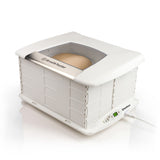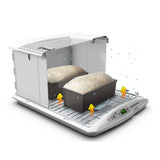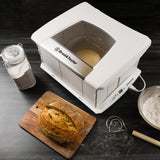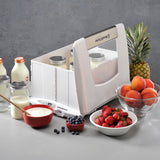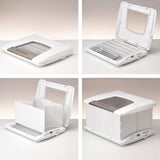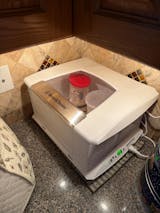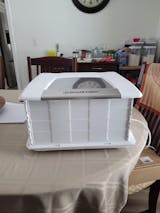Folding Proofer & Slow Cooker
Folding Proofer & Slow Cooker
Specifications
- Temperature Range: 70–195F / 21–90C
- Typical Humidity: 60-80%
- Body Material: Reinforced Polypropylene
- Water Tray Material: Aluminum
- Heating Plate Material: Solid Brushed Aluminum
- Dimensions (Interior): 14.75 x 12.5 x 8 in high, 8.5 in high without rack / 37.5 x 32 x 20 cm high
- Dimensions (Exterior Open): 18 x 14.5 x 10 in high / 46 x 37 x 25.5cm high
- Dimensions (Exterior Closed): 18 x 14.5 x 2.75 in high / 46 x 37 x 6.5cm high
- Weight: 9.5 lbs / 4.3 kg
- Power: 120V, 60Hz (200W) -- 220-240V, 50Hz (180-220W)
- Part Storage: Rack and water tray fit inside Folding Proofer for storage.
- Model Number: U.S.A. and Canada (120V): FP-105 -- International (220-240V): FP-205
FAQ
What size bread pans will fit in the Proofer?
Two “large” loaves, approximately 2lb / 900 g each of dough. The Brød & Taylor Shelf-Kit accessory will double capacity. Interior space of the Proofer is 14.75 x 12.5 x 8” high / 37.5 x 32 x 20cm high. If overall pan size with rims and/or handles is less than 12 x 14″ – 30.5 x 35.5 cm the pan will fit. For the best circulation of warmth and humidity, place pans towards the center of the Proofer. Many of our customers also purchase supplies from King Arthur Flour. We have a chart of KAF pan sizes that fit correctly in the Proofer and also pans which will not fit in the Proofer. The chart may be helpful when considering a purchase at King Arthur Flour or another store. KAF Pan Size Chart
I have been making bread for years. Do I need a Proofer?
Home bakers are often disadvantaged because they lack a well-controlled fermenting and proofing environment. Most bakers understand that great bread requires quality ingredients. However, even with the best ingredients, homemade bread often lacks flavor, texture, and is uninteresting in every sense. This is because bakers are missing the one ingredient they need most: Time at the right temperature. The single step that differentiates great bread from mediocre bread is giving the dough a chance to ferment slowly at the ideal temperature. The Proofer allows you to create the best texture and taste in homemade bread with repeatable and consistent results.
What is the difference between the Proofer and a bread machine?
The Folding Proofer is not a bread machine. It is a proofing environment for the fermenting and rising of yeast dough. It eliminates the troublesome temperature and humidity variables that have made it difficult for all bakers–beginners and professionals who bake bread at home. With the Folding Proofer, there is no longer a difficulty finding that “warm, draft free place” in your home for dough to rise. The Proofer makes it possible to bake bread at home with predictable, excellent results. Compared to a loaf made in a bread machine, you will find hand-made bread has improved texture and taste. You still mix your own dough and for some breads knead by hand or with a mixer. You may use your own pans or bake free-form loaves in traditional shapes. Higher-quality, more delicious loaves are made with a temperature-controlled proofing environment and baking in a separate pre-heated oven.
Can the Proofer run for more than a few hours at a time?
Yes, the Proofer has been tested and approved for unattended operation and may be run continuously. It uses very little electricity, only about 0.03 kwh per hour when set at 75 °F / 24 °C.
What temperature setting is optimum for different types of bread?
There is a range of temperatures that work well for bread dough, and if the recipe or book you are using specifies a temperature, consider using that setting. - Sourdough works well fermenting at a temperature of 80-86 F/ 27-30 C in order to give the wild yeast a boost. - Commercial yeast is more vigorous, so dough made with it benefits from a lower temperature that promotes flavor development, 75-79 F / 24-26 C. - Sweet doughs and croissants often contain butter and do best when temperatures are kept below the melting point of butter. We recommend 80 F / 27 C or lower for these doughs. - Rye flour has weaker gluten and higher enzyme activity. Higher Proofer temperatures are appropriate (80-86 F / 27-30 C) to shorten fermentation time and keep the enzymes from degrading the dough too quickly. - Cold dough that has been retarded in the refrigerator often needs an extra hour (or more per pound / 500g of dough) added to its rising time, to allow the dough to come up to temperature. Ideally, frozen dough should be thawed in the refrigerator before proofing.
Why isn’t the air temperature inside my Proofer the same as the setting?
The Proofer is calibrated to keep the contents of a jar or bowl at the designated temperature setting, not the air inside. Measuring the air temperature in the proofer with a thermometer will not indicate the temperature of food in a container. This is because the Proofer heats mainly by radiative heating directly from the aluminum heating plate in the base to the food containers. The air temperature inside the Proofer will become warm, but will not be the same as the temperature of food inside containers. In Proofer mode, items should always be placed on a rack. There are two important factors that affect the temperature of food in the Proofer: - Covering a container will raise the temperature of the food inside the container - Adding water to the tray to create humidity will raise the temperature of food in the container. The Proofer has been calibrated in two ways: - Humid (with water tray): 70-95 °F / 21-35 °C. Use open containers. Bread dough and preferment in open bowls, loaf, or sheet pans. - Dry (no water tray): 70 -120 °F / 21 – 49 °C. Use closed containers. Commonly used for culturing yogurt. If the Proofer is used in dry mode at 70-95 °F / 21-35 °C food temperatures may be several degrees below the setpoint.
Should I cover my bread dough?
Most dough and shaped loaves do not need to be covered while in the Proofer because the water tray will provide ideal humidity to keep the dough from forming a skin. All bread recipes on the Brod & Taylor website are developed with temperature settings for uncovered dough. If the dough is covered you may find an increased dough temperature of 2-5 degrees depending on the length of time the dough is in the Proofer. However, if using the Proofer for an extended fermentation, such as an overnight pre-ferment at a low temperature, it may be safest to cover the bowl or container.
What is the difference between fermenting and proofing?
Fermenting is where the flavors are created and takes much longer than the proofing stage. Fermentation begins when yeast (instant or natural air-borne) is introduced to flour and water. The pre-ferment is a controlled aging process that allows the yeasts to eat at will since there are so few of them at first. Proofing is the final gas production that aerates the dough so it isn’t dense and gummy. Proofing is still fermenting. Sometimes called the final ferment. A single bread dough loaf is bulk fermented after mixing and kneading. After it is shaped it is called proofing or the “final ferment”.
My Proofer doesn’t seem to be getting warm enough – is it working properly?
If your Proofer is set to a cooler temp 75 °F / 24 °C, it may not feel very warm to the touch even when it is working properly. To speed rising, set it to 85-90 °F / 29-32 °C. If you have been rising bread in an oven or other area that is quite warm, you may need to set the Proofer temperature higher to obtain similar results. However, the best flavors in bread are usually obtained when the dough is given enough time to rise slowly.
My Proofer seems to be getting too warm – is it working properly?
For the best heat circulation and most accurate culturing temperature, avoid placing jars or containers directly in the center of the Proofer. The Proofer will fit eight one quart (1 liter) mason jars without the need to place a jar in the center. For cultures or fermentations that require extended times (>12 hours) more stable results may be achieved in the Slow Cook mode, which may be set as low as 85 °F / 30 °C. Jars or other containers of food can be placed inside a larger flat bottom container (such as a stock pot or aluminum roast pan) and covered with a lid or foil and placed directly on the heating plate. Choose Slow Cook with the Mode button and set the desired temperature.
Can household ovens with a low temperature setting be used to proof?
1. Low temperature ovens do not control and hold at the single degree-by-degree temperature level. 2. Low temperature ovens do not have proper humidity control The lowest temperature on a low temperature oven can not maintain the very low range of temperatures starting at 70F – 21C temperature. 3.Our Proofer is calibrated by engineers to maintain the internal food temperature of the bread dough, yogurt culture, or whatever food is being made in the Proofer. A low temperature oven is set for the air inside the oven, not the ingredients a person is making. The recipes developed by Brod & Taylor have been successfully tested at the specific temperature settings indicated on each recipe.
Does the Proofer have a thermostat?
Yes, there is a thermostat located in the base of the Proofer. The heating element cycles on and off according to the temperature of the aluminum plate. This cycling on and off occurs within a very narrow range, making the Proofer very accurate and reliable at maintaining a steady temperature.
Will the Proofer work in any environment?
The Proofer has been calibrated for a room temperature of 65 – 70 °F / 18 – 21 °C. The Proofer is only designed to warm its contents, not cool. If the room temperature is above the set point, the Proofer cannot be cooler. If the ambient is very cold – lower than 55 °F / 13 °C, the temperature setting may need to be adjusted a few degrees higher to achieve the desired result.
The lid will not shut when folding the Proofer.
1.Make sure the folding sides are collapsed correctly and attached to the hinge at the inside back of the base.
2. Ensure the small plastic cross guides are visible on the top.
3. Place the wire rack with feet UP so it is secured by the cross guides.

How long should I preheat the proofer?
Generally, just preheat for 10-15 minutes.
What is the best way to proof baguettes in the Proofer?
Place the baguettes on a bakers couche placed on a flat pan or other non-absorbent flat support. We cut a full-sized baker’s couche in half so there wasn’t too much fabric blocking the humidity. With the Shelf-Kit accessory two racks of baguettes are an option, so we like having the two pieces of Baker’s Couche for Proofer uses. The couche is lightly floured and never washed. Keep it shaken out after each use and lightly re-flour each time before use. Place the bakers couche on a small flat sheet pan for ease in handling in and out of the Proofer. Flat pans are optimum so you can gently roll each baguette onto a peel. We always warm up the Proofer about 30 minutes prior to proofing and make sure water is in the tray below.
My dough often becomes sticky. What causes this?
Sticky dough is often caused by over hydration or over proofing. Yeast microbes can’t travel on their own for new food so punching down or degassing does that for them. Under normal conditions there is enough food for the yeast to rise again after at least one punch down and a second rise. Eventually the yeast will eat so much food the dough starts to break down and become really sticky. It is ruined as soon as that starts to occur.
The folding sides of my Proofer came apart, how do I put them back together?
Video Instructions In order to prevent the folding sides from coming apart, we recommend always leaving them attached to the base of the Proofer in the rear hinges, even during folding and set up.
Is the Folding Proofer noisy?
No, operation of the Folding Proofer is silent.
How does the lid of the Proofer attach to the sides?
When the Proofer is set up, the lid rests on the walls. It does not click into place or latch. However, there is a specific way to line up the lid so that it fits properly. The two square pegs at the rear of the lid fit into the square-shaped notches at the rear wall, then the lid hinges down onto the walls.
What is the power consumption of the Proofer per hour?
The Proofer consumes 200 watts. When it is operating it has a duty cycle of about 30%. This means the heater is only using 200W for 30% of the time, depending on the temperature (the lower the temperature the less the time the heater has to run). If the Proofer was ON 100% of the time it would use: - 200 watts x 1 hour = 200 watt hour (= 0.2kwh) But since it is only on about 30% of the time, the actual energy consumption is: - 200 watt hour x 0.3 = 60 watt hour = 0.06 kWh / hour In other words, it uses the same energy as a 60 watt light bulb.
How is the Slow Cooking mode different?
Slow cooking mode directly controls your pot temperature though the aluminum plate. This is different from proofing mode, where the temperature of the plate is calibrated to keep your dough, yogurt, or other food at a certain setpoint temperature.
Comparing temperature settings on The Folding Proofer and Slow Cooker to a traditional slow cooker requires some explanation. Most conventional slow cookers (typically with only Low and High settings) actually have no temperature control at all. They heat slowly and continuously until the maximum temperature is reached – usually boiling. This means for much of the time you are slow cooking, your food is actually below or above the actual ideal cooking temperature. With many slow cookers Low and High settings are actually identical. Certain “multi-cooker” appliances with a slow cook function do have temperature control, although performance varies greatly between brands and there is no universal standard for Low or High setting.
Our Folding Slow Cooker uses calibrated temperature control to maintain the selected temperature. You can choose the ideal cooking temperature for your recipe without worrying about over-cooking your food. Temperature settings are most accurate using a stainless steel pot with a flat bottom, but most any type of metal pot can be used.

What kind of pot should I use for slow cooking?
Temperature settings will be most accurate using a stainless steel pot with a thick flat base. The best choice will have some type of heat conductive metal in the base such as aluminum. All Clad ™ stockpots are among our favorites, but there are many other brands. It is possible to use cast iron Dutch ovens, either bare or porcelain coated, but these pots may be 10-15 °F / 5-8 °C below the temperature setting at the highest temperatures. To achieve the highest temperature in a cast iron Dutch oven wrap it in a single layer of aluminum foil to greatly reduce its heat loss. Porcelain enameled cast iron Dutch ovens will get as hot as stainless steel pots if they are wrapped in aluminum foil.
 The photographs above are of the same pot. The one on the right was taken with an infrared camera. In this photo on the right side of the pot, where there is no aluminum foil wrap, you can see tremendous emissivity of thermal heat (thermal heat energy loss). When using a recipe where a high temperature of 195 °F / 90 °C is indicated (as in pork recipes), wrapping an enamel-coated cast iron pot or a cast iron & glass-top pot with one layer of foil on the sides and pot lid will allow the internal temperature of the pot to rise. If the temperature is set to 195 °F / 90 °C the Proofer & Slow Cooker will not allow the internal contents of the food to rise above 195 °F /90 °C.
The photographs above are of the same pot. The one on the right was taken with an infrared camera. In this photo on the right side of the pot, where there is no aluminum foil wrap, you can see tremendous emissivity of thermal heat (thermal heat energy loss). When using a recipe where a high temperature of 195 °F / 90 °C is indicated (as in pork recipes), wrapping an enamel-coated cast iron pot or a cast iron & glass-top pot with one layer of foil on the sides and pot lid will allow the internal temperature of the pot to rise. If the temperature is set to 195 °F / 90 °C the Proofer & Slow Cooker will not allow the internal contents of the food to rise above 195 °F /90 °C.
 One easy method is to place 2 pieces of foil on a flat surface with the pot in the middle and then wrap to cover the pot and lid.
One easy method is to place 2 pieces of foil on a flat surface with the pot in the middle and then wrap to cover the pot and lid.
Can I use ceramic crocks or ramekins in the Folding Proofer & Slow Cooker?
Slow cooking should always be done in a metal pot. Ceramic crocks and ramekins do not conduct heat well and will not reach the temperature set point.
Why isn’t my pot hot?
Make sure that you have removed the rack from your Proofer. The pot must sit directly on the aluminum heating base plate. Food temperature in the pot will vary somewhat depending on the type of pot. Temperature settings are most accurate using a stainless steel pot with a thick base and flat bottom.
How long can I leave food in the slow cooker?
There is no specific limit on how long the Folding Proofer & Slow Cooker may be run. Most slow cook recipes will take a maximum of 10-12 hours. Slow roasting black garlic will take up to four weeks at 140 °F / 60 °F. The Folding Proofer original model FP-101 can also be operated for weeks and months at a time.
Is there a “stay warm” temperature?
You may reduce the temperature setting to 160 °F / 71 °C to safely hold food at a warm temperature. As an extra precaution, we suggest that you double check the temperature of the food to ensure that it is above 150 °F / 66 °C. Always keep a tight fitting lid on your cooking pot inside the closed Folding Proofer & Slow Cooker.
I want to use a non-Brod & Taylor Slow Cooker recipe – how do I convert settings and times?
Use the same times recommended for cooking on LOW in a conventional slow cooker.
Can I cook overnight?
The Folding Proofer & Slow cooker is approved for unattended use and can be used overnight. Please be sure to follow all safety instructions in the Instruction Manual whenever using this appliance, and especially when it is used unattended.
What plastic materials are in the Folding Proofer?
The proofer has passed the most recent and stringent RoHS3 test currently required in the EU (there is no such requirement in the USA). RoHS means Restriction of Hazardous Substances. RoHS3 tests for 10 classes of restricted substances and sets maximum levels. Every single part of the proofer was tested. RoHS specifies maximum levels for the following restricted materials: • Lead (Pb): < 1000 ppm • Mercury (Hg): < 100 ppm • Cadmium (Cd): < 100 ppm • Hexavalent Chromium: (Cr VI) < 1000 ppm • Polybrominated Biphenyls (PBB): < 1000 ppm • Polybrominated Diphenyl Ethers (PBDE): < 1000 ppm • Bis(2-Ethylhexyl) phthalate (DEHP): < 1000 ppm • Benzyl butyl phthalate (BBP): < 1000 ppm • Dibutyl phthalate (DBP): < 1000 ppm • Diisobutyl phthalate (DIBP): < 1000 ppm Test Methods: For heavy metals and flame retardants – Energy Dispersive X-ray Fluorescence Spectrometers (XRF); For phalates – Gas chromatography and mass spectroscopy (GC – MS). All tests PASSED with most tests results being below detectable limits. The majority of large parts of the proofer (white parts) and made from polypropylene (PP). It is one of the safest plastics and also highly resistant to temperature. (Plastics information From Healthline.com) Of the commercial plastics on the market today, polypropylene is considered one of the safest. It’s FDA-approved for food contact. Polypropylene is used for food containers such as those that hold yogurt, cream cheese, and butter. Because it has a high heat tolerance, it is often used in packaging of food that can be heated in a microwave. Some surgical devices and implants are also made of polypropylene, and polypropylene fibers are commonly used to weave area rugs for indoor and outdoor use. Polypropylene, which is derived from petroleum, is considered by the Environmental Protection Agency (EPA) to be a safer choice than some other types of plastics. It’s not known to cause cancer in humans, and it’s less flammable in fabrics than wool. Is polypropylene BPA free? Bisphenol A (BPA) is a chemical used in the manufacturing of polycarbonate plastics. It’s also used in epoxy resins that coat the insides of canned goods and water supply pipes. BPA leaches into food and water supplies easily. More than 93 percent of the urine samples examined in a CDC study contained BPA concentrations. Although the FDA has said that small amounts of BPA are safe for humans, some environmental and health experts are concerned that exposure to BPA could lead to problems with brain development, immune function, learning abilities, reproductive disorders, and other health issues. The growing concern around BPA has led to the production of several types of BPA-free plastics. Polypropylene is one type of plastic that’s free of BPA. The clear plastic window on the proofer lid is NOT polycarbonate. It is a plastic called SAN. SAN. It is widely used in place of another clear plastic, polystyrene, owing to its greater thermal resistance. SAN is BPA free.
I spilled food all over the bottom of the slow cooker—how do I clean it up?
Do not immerse the base unit in water if the unit becomes soiled, instead use a soft cloth with a bit of water to remove the spill. As a preventative measure before using the Proofer, you can place a piece of aluminum foil on the base plate beneath the pot so that any spill is easy to collect and discard.
Innovative folding design. Big enough to fit a large mixing bowl, several hand-shaped loaves, 2 gallons of yogurt, or your favorite 8 quart pot, yet easily folds flat (with rack and water tray stowed inside) for convenient and compact storage in a kitchen drawer.
One appliance. Endless uses. A true multi-tasker, the proofing box can be used to keep your sourdough starter strong, your bread dough warm and rising, and your kombucha brewing. It can become a homemade yogurt machine or turn your favorite pot into your favorite slow cooker.
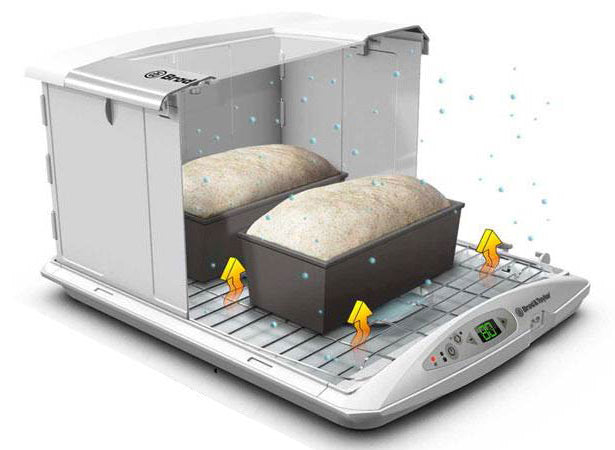
Breadbaker's Dream Machine

One Pot Slow Cooking

Culture Perfection
Proofing Box
Bread rising down to a science
Precision control gives you consistent temperature
and humidity for perfect results every time.
Bread & Sourdough Recipes


Slow Cooker
True one-pot meals
Slow Cook Mode provides constant conductive heat
to prevent over or under-cooking.
Slow Cooking Recipes
Fermenter &
Yogurt Maker
Create custom cultures
High-Low temperature method produces
a smooth texture for yogurt.
Probiotics Recipes
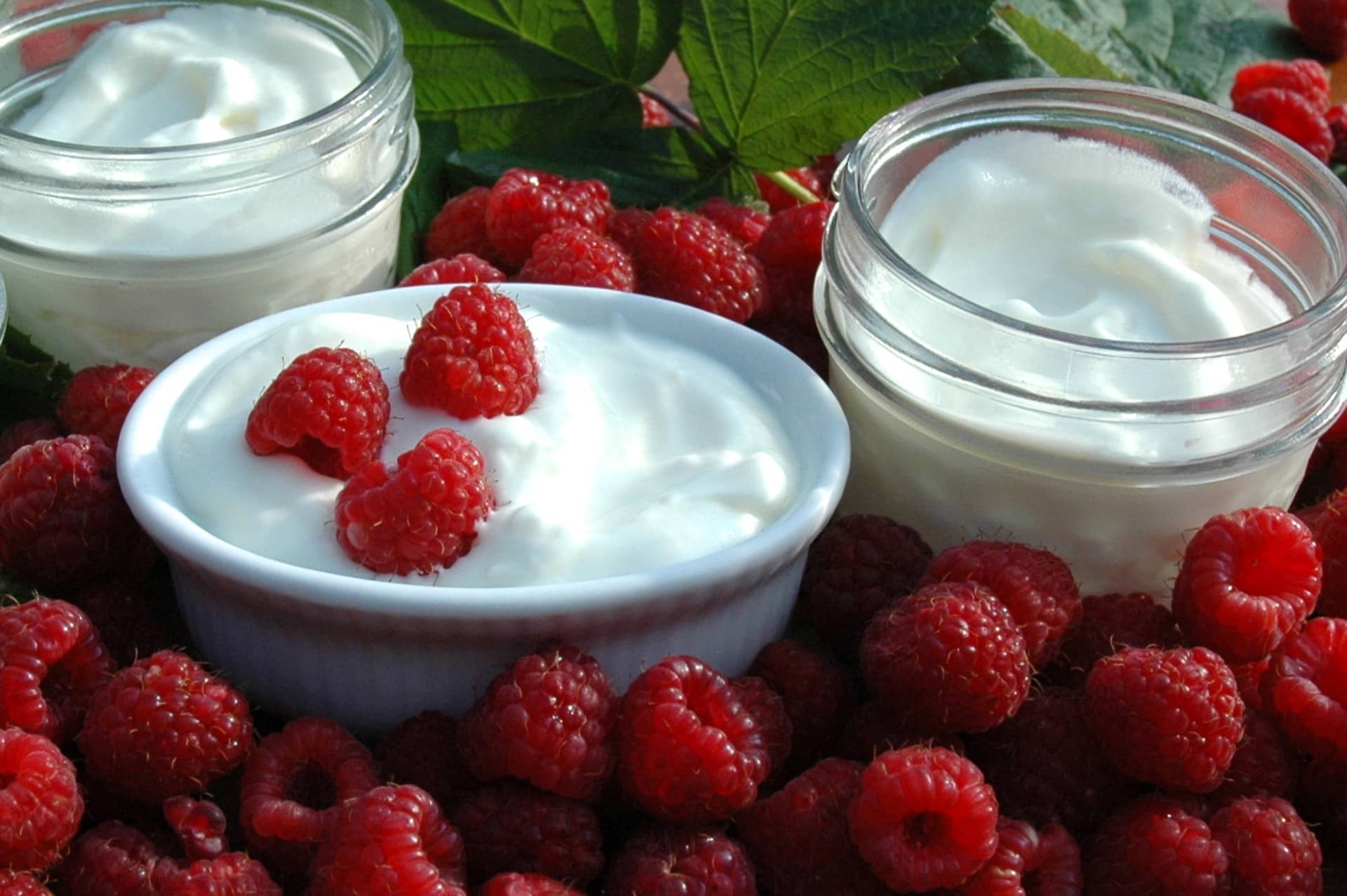


Environmentally sustainable packaging. We have a Zero Styrofoam policy and are continuously working to reduce or eliminate non-recyclables from our packaging, while still ensuring our products arrive in pristine condition. The Folding Proofer uses 100% recyclable molded fiber to secure and protect it while shipping.
Featured in:
"Baking sourdough bread with consistent quality can be a challenge in the home kitchen. Thankfully, the Brød and Taylor Folding Proofer & Slow Cooker is here to ensure your dough (or sourdough starter) is always kept at the right temperature. After using mine for years, it's hard to imagine baking without it."

Maurizio Leo
The Perfect Loaf
"What all avid bakers have been waiting for: a bread proofer ideal for home use."

Rose Levy Beranbaum
The Bread Bible
“The Brod & Taylor SAHARA Folding Dehydrator and the Folding Proofer and Slow Cooker are essential to what I do. I’ve used these tools nearly every day since I got them. If you’re at all interested in doing bread, fermentation, dehydrating, or just about anything interesting in your cooking, then you need to have these in your kitchen.”

Joshua Weissman
The Slim Palate

















